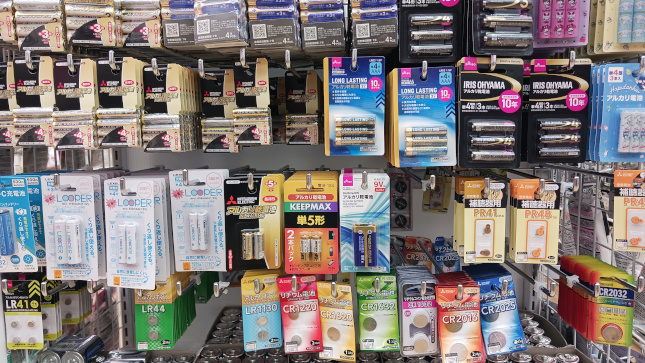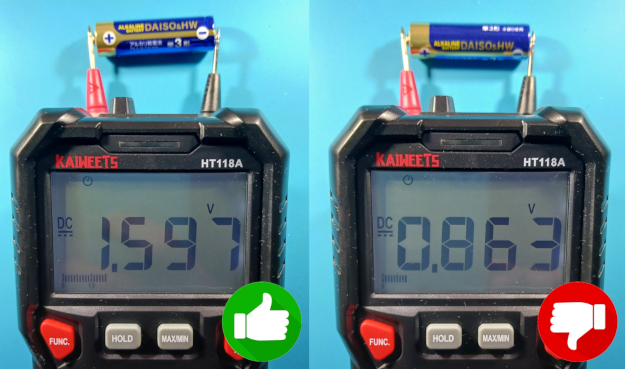I would like to start by saying a big thanks to my parents and all parents of the world. Growing up I received my fare share of presents that operated using batteries. But I never remember opening a present and not being able to play with it right away. This is despite the fact that most toys did not come with batteries. The reason? Parents were always prepared, either having a battery stash in the kitchen drawer, or following the clerk’s suggestion to buy some when purchasing the toy.

We know how to use a battery. But what is it?
All batteries are made of two chemicals, kept separately inside the battery. One chemical has extra electrons, and the other is missing some. This makes them really, really want to get from one side of the battery to the other. But we don’t let them. Oh no. We put a barrier inside the battery so that the two chemicals always stay apart. We then expose each chemical to a different metal end on the outside of the battery. Now, only when the two ends are connected, the extra electrons can rush to the other side.
So, when we are looking at a new battery sitting at the table, we can imagine an athlete at the start line of the track, bent down, fingers on the floor, ready to explode towards the finish line. This is a battery’s electric potential, measured in volts.
We know volts. Most small batteries we use daily are 1.5 volts. We can connect these batteries together and make batteries with more volts. A little known fact is that the typical 9 volt battery used in some toys has 6 small 1.5 volt batteries inside. Even the big 12 volt ones used in cars are made from many smaller batteries, also called cells.
What is so special about 1.5 volts?
Like we said before, all batteries use two chemicals inside. Zinc and Manganese, Lithium and Iron Sulfide, Nickel and Cadmium. These are just some of the chemical pairs that scientist have discovered so far. These chemicals naturally produce this amount of electric potential during their chemical reaction. Around 1.5 volts. There are other chemical combinations, and new pairs are always being researched, but so far, most single cell batteries are between 1 and 4 volts.

What’s up with all the shapes and sizes?
Thanks to standardization, most products that require batteries can be bought without checking in advance what battery type they use. We know it will probably be the prevalent AA, the ubiquitous AAA, or the rare but still readily available D type. We can find all of them pretty much everywhere.
But what to do when a device is too little? How can one fit a long cylinder in a tamagotchi? Product manufacturers decided to solve that problem by making smaller batteries. Containing the same chemicals, these small batteries can also output 1.5 volts despite their small size. But having less material inside, means they can sustain the output for a shorter amount of time. Simply put, a device would run longer with an AA battery than with a small button type battery.
But we can also make longer lasting batteries by putting many cells together. Wait a second! Didn’t we say that putting many cells together increases the voltage? Yes! But if instead of putting batteries one after the other we put one next to each other, that keeps the voltage the same but increases the capacity! We can use a mix of putting batteries one after another (in series) and one next to another (in parallel) to create batteries of all sorts of voltage and capacity.
Where do batteries go when they die?
When a device using batteries stops working, it is not because the batteries are completely used up, but because the device itself refuses to work with those batteries any longer.
Just like the runner on the track, who sprints for 100 meters and then has to lay down, there is only so much energy batteries can supply before they “get tired.” When most electrons from the surplus side have traveled over to the other side, the flow starts slowing down, and that causes the potential energy to drop. 1.5 volts become 1.3, then 1.2, and at some point it drops below 1.
When a device needs one AA battery to work, it means that it needs a continuous supply of around 1.5 volts. A spent battery can only supply around 1 volt which is not enough for that device. So the device stops working until we replace that battery with a fresh 1.5 volt one. Funny thing is, if we have another device that works with 1 volt batteries, that previously spent battery will work just fine!

Can’t we just recharge the dead batteries?
Unfortunately, not all batteries are rechargeable. Single-use batteries use chemicals that once put together cannot be separated again. That’s why scientists tried to find some other chemicals. And they were successful! They discovered that some chemical combinations can send the extra electrons back to one side when electricity is applied to the battery in reverse. Then the battery is once again ready to provide energy, as if nothing had happened.
A lot of electronic devices nowadays do not need replacement of batteries. They use a USB charger to replenish the energy of a built-in rechargeable battery they have inside. This is good! Battery recharging technology has allowed us to reduce the constant replacement of batteries and in turn reduce the amount of dead batteries that ends up in landfills.
But the recharging technology is not perfect. Every time we recharge a battery, it damages the chemicals inside, which results in lowering the battery’s capacity. This is why, after a certain number of recharges, the battery lasts so little that is practically no longer usable. That is a dead rechargeable battery. But now, since this battery is inside a device with no way of changing it, the device itself becomes unusable. This contributes to the problem of electronic waste (e-waste) and it is a problem just as severe as the problem of battery waste.
We powered through this.
Batteries are pretty cool. They let us use electronics on the go, but also store energy for emergencies. But how do we actually use that energy? How can those electrons, rushing from one side of the battery to the other, make a light turn on? Since the discovery of electricity we have been trying to answer questions like those, and every answer, however small, has made our quality of life better. This is why we keep looking for new and better ways to utilize electricity, and learning about batteries is just the beginning.
